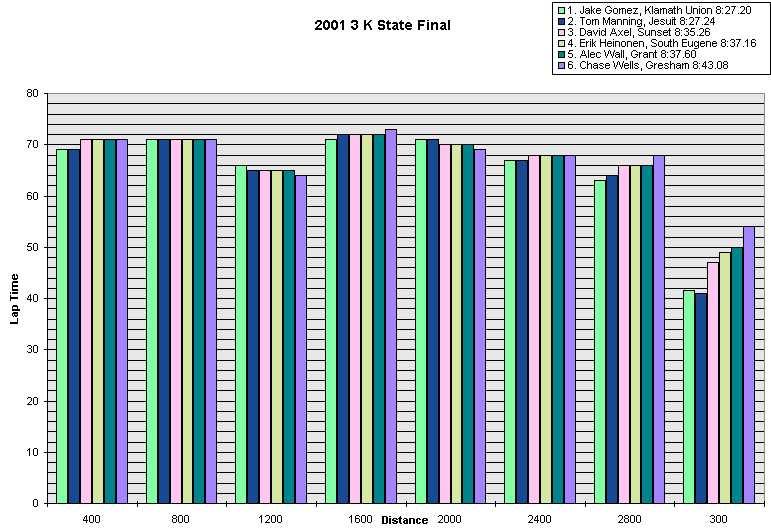|
The oxygen delivery system you have developed from pace workouts couple with your lactic acid work developed from sprint workouts and race shocking will determine what you can run in an optimum race. Unfortunately in competition there are other runners that are going to get in your way and throw off your rhythm. It is a common practice at championships for the best kickers to position themselves at the front at the beginning of the race, intentionally keeping the race slow. They are concerned about not having their advantage negated by an evenly paced race.
Take a look at the mens 3000 meter final at state in 2001. 
400 800 1200 1600 2000 2400 2800 300
1. Jake Gomez, Klamath Union 8:27.20 69 71 66 71 71 67 63 41.6
2. Tom Manning, Jesuit 8:27.24 69 71 65 72 71 67 64 41
3. David Axel, Sunset 8:35.26 71 71 65 72 70 68 66 47
4. Erik Heinonen, South Eugene 8:37.16 71 71 65 72 70 68 66 49
5. Alec Wall, Grant 8:37.60 71 71 65 72 70 68 66 50
6. Chase Wells, Gresham 8:43.08 71 71 64 73 69 68 68 54
Looking at the pace of the top 6 finishers it appears as if they ran in a close pack the majority of the way. There were actually 3 different "rabbits" (OC's Faulkner, Roseburg's Roberts, and David Douglas' Hambrick)who made large charges and gain a seperation of at least 8 meters on the pack. The lead pack keyed off Gomez and Manning.
The difference maker in the race came in the third lap where Manning and then the group went after Roberts on the breakaway. They actually ran their slowest lap on #4 after exerting themselves. The jossling within the packs were done after lap 2.
Now look at the last 300 meter times. Manning and Gomez run 41 while the best of the rest couldn't muster better than a 47.
This next year's final will greatly resemble this past cross country season. Wall from Grant will push hard from the beginning because he doesn't have confidence that he can hold off Gomez and other fast-closers. Axel has slightly better speed than Wall, but Gomez is still better. Axel will position himself near the front with Gomez and make his break at lap 5 and not let up, hoping that Gomez will have crossed over into lactic acid before the last 400. Axel will practice this tactic all season, increasing his strength over the last 3 laps, with less focus on pure speed. Gomez will be doubling the 1500 and 3000 and will want to conserve energy for the next day. He will stay right with Wall and wait to kick at the end. Wall will fade about lap 6 when Axel has run away from him.
Now if I were an unknown outsider like Roadmap, how would I approach this race with the intent to win?
1. Don't lead until after the mile.
2. Develop your 800 speed. If you are close with 800 to go and you can run sub 2:10, you have a real shot at knocking them off. You have to be able to run an open 800 aerobically in 2:10.
3. Practice your sustained late surges just like Axel. Don't become overexcited and go anaerobic within the first 200 meters of your surge. Stay true to the pace and muscle memory training you've done. Maintain form and remember footwork, especially with 550 meters to go. |

